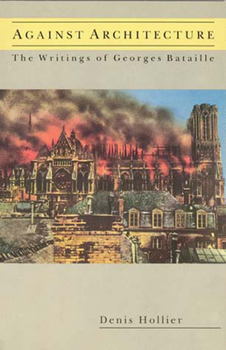Against Architecture: The Writings of Georges Bataille
(Part of the October Books Series)
Select Format
Select Condition 
Book Overview
Over the past 30 years the writings of Georges Bataille have had a profound influence on French intellectual thought, informing the work of Foucault, Derrida, and Barthes, among others. Against... This description may be from another edition of this product.
Format:Paperback
Language:English
ISBN:0262581132
ISBN13:9780262581134
Release Date:February 1992
Publisher:MIT Press
Length:232 Pages
Weight:0.80 lbs.
Dimensions:0.6" x 5.9" x 9.0"
Age Range:18 years and up
Grade Range:Postsecondary and higher
Customer Reviews
1 rating
Hegel vs. Bataille on Architecture's relationship to Philosophy
Published by Thriftbooks.com User , 15 years ago
From Front Flap: "Over the past 90 years the writings of Georges Bataille have had a profound influence on French intellectual thought, informing the work of Michel Foucault, Jacques Derrida, Roland Barthes, Jean Baudrillard, and others. 'Against Architecture' offers the first serious interpretation of this challenging thinker, spelling out the profoundly original and radical nature of Bataille's work. It has already become the standard critical work on Bataille in France, where it was published in 1974 as 'La Prise de la Concorde.' Taking into account the Bataillian requirement that such a commitment operate not only on the theoretical plane, Holier's own writing echoes Bataille's position that writing is always linked to discord or disharmony. 'Against Architecture' opens, in fact, with two beginnings, the second of which is bent on undoing the first. The initial beginning is a theoretical excursus on Hegel's aesthetics, showing how the commanding position architecture is given in Hegel's philosophical edifice underlies a deeper and more fundamental modeling of his philosophical system according to the pattern of architecture - a modeling that turns philosophy itself into the servant of architecture. The second beginning is an analysis of Batailles' earliest text: a fervent prayer for the restoration of the Cathedral of Notre-Dame at Reims after its bombing during World War I. This religious meditation Hollier sees as the paradoxical origin of the long series of violations at work in Bataille's later writings. In the second half of the book, 'The Caesarean,' Hollier analyzes the interplay between two modalities of built space - the pyramid and the labyrinth. The labyrinth was the elusive, almost invisible model of spatiality through which Bataille induced the undoing of structures linguistic as well as architectural. Hollier looks at the way that Bataille went on to map the space of the labyrinth onto the space of the body, and at the myths - the Pineal Eye, the Solar Anus - that developed to project this complementary systmem."




